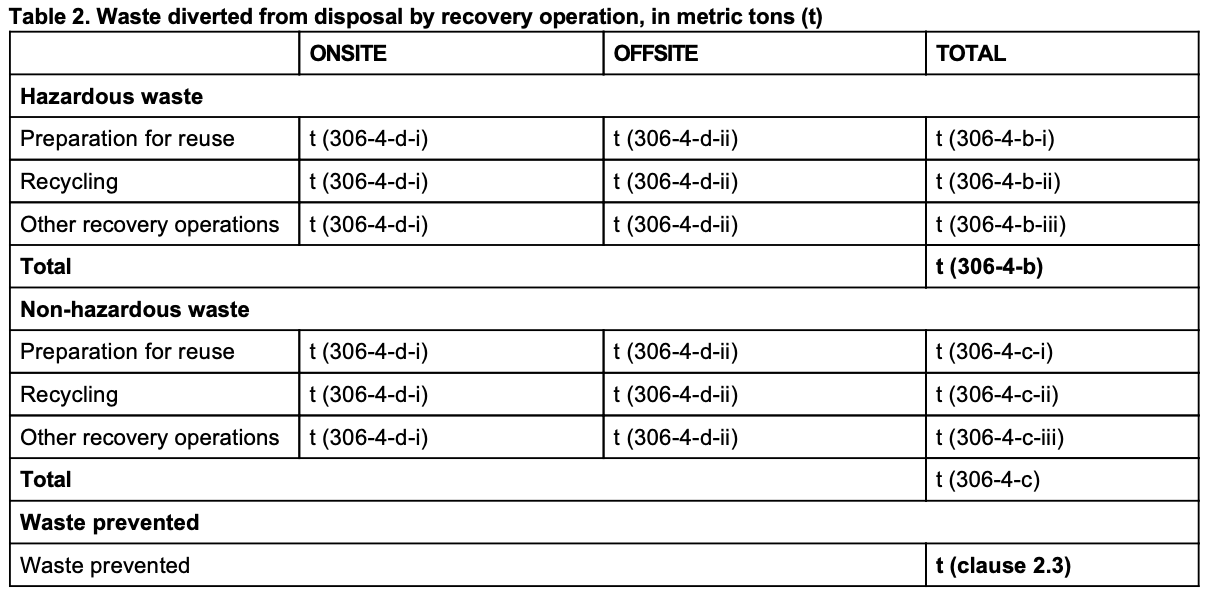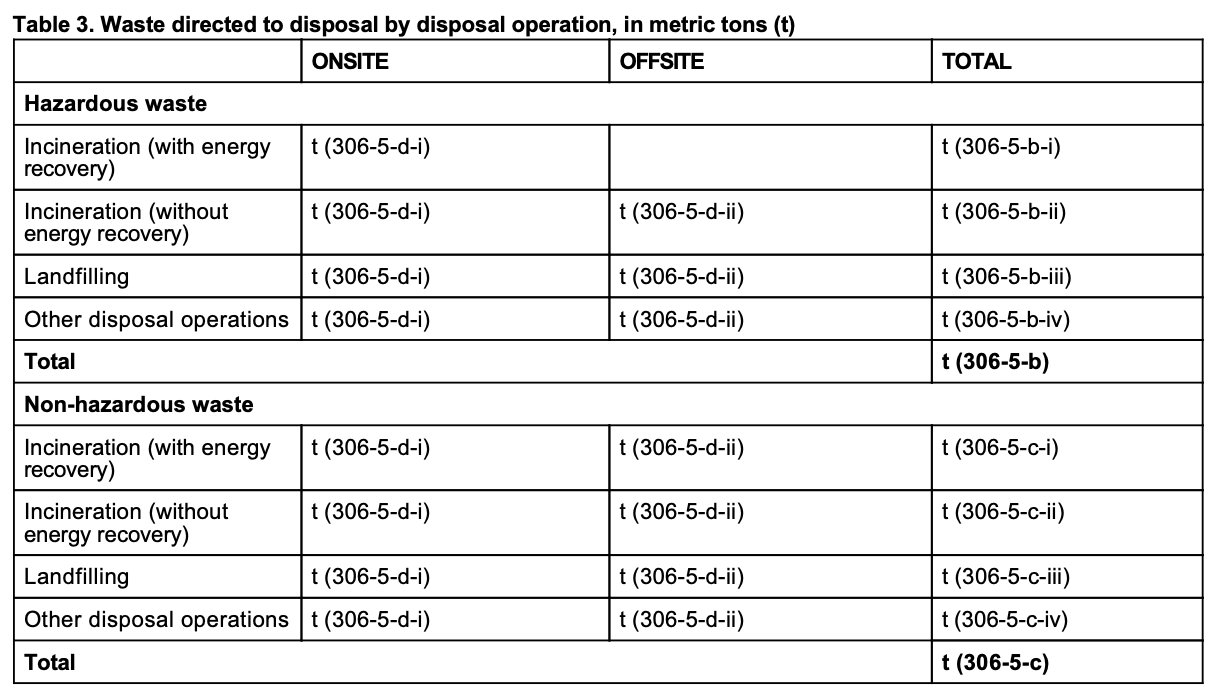GRI 306: Waste 2020
EFFECTIVE DATE: 1 JANUARY 2022
Introduction
GRI 306: Waste 2020 contains disclosures for organizations to report information about their waste-related impacts, and how they manage these impacts. The disclosures enable an organization to provide information on how it prevents waste generation and how it manages waste that cannot be prevented, in its own activities and upstream and downstream in its value chain. The Standard is structured as follows:
- Section 1 contains two disclosures, which provide information about how the organization manages its waste-related impacts.
- Section 2 contains three disclosures, which provide information about the organization’s waste-related impacts.
- The Glossary contains defined terms with a specific meaning when used in the GRI Standards. The terms are underlined in the text of the GRI Standards and linked to the definitions.
- The Bibliography lists authoritative intergovernmental instruments and additional references used in developing this Standard.
- The Appendix includes examples of process flows and examples of templates for presenting information for Disclosures 306-3, 306-4, and 306-5.
The rest of the Introduction section provides a background on the topic, an overview of the system of GRI Standards and further information on using this Standard.
Background on the topic
This Standard addresses the topic of waste.
Waste can be generated in the organization’s own activities, for example, during the production of its products and delivery of services. It can also be generated by entities upstream and downstream in the organization’s value chain, for example, when suppliers process materials that are later used or procured by the organization, or when consumers use the services or discard the products that the organization sells to them.
Waste can have significant negative impacts on the environment and human health when inadequately managed. These impacts often extend beyond locations where waste is generated and discarded. The resources and materials contained in waste that is incinerated or landfilled are lost to future use, which accelerates their depletion.
The United Nations recognizes the role of responsible consumption and production in achieving the Sustainable Development Goals. The targets under Goal 12, in particular, call on organizations to implement environmentally sound waste management and prevent and reduce waste through reuse and recycling.
1. Topic management disclosures
An organization reporting in accordance with the GRI Standards is required to report how it manages each of its material topics.
An organization that has determined waste to be a material topic is required to report how it manages the topic using Disclosure 3-3 in GRI 3: Material Topics 2021 (see clause 1.1 in this section). The organization is also required to report any disclosures from this section (Disclosure 306-1 through Disclosure 306-2) that are relevant to its waste-related impacts.
This section is therefore designed to supplement – and not replace – Disclosure 3-3 in GRI 3.
REQUIREMENTS
- 1.1 The reporting organization shall report how it manages waste using Disclosure 3-3 in GRI 3: Material Topics 2021.
Disclosure 306-1 Waste generation and significant waste-related impacts
REQUIREMENTS
The reporting organization shall report the following information:
- a. For the organization’s significant actual and potential waste-related impacts, a description of:
- i. the inputs, activities, and outputs that lead or could lead to these impacts;
- ii. whether these impacts relate to waste generated in the organization’s own activities or to waste generated upstream or downstream in its value chain.
RECOMMENDATIONS
- 1.2 The reporting organization should report a process flow of inputs, activities, and outputs that lead or could lead to significant waste-related impacts.
GUIDANCE
Background
The quantity, type, and quality of waste generated by an organization is a consequence of the activities involved in the production of its products and services (e.g., extraction, processing, procurement of materials, product or service design, production, distribution) and their subsequent consumption. An assessment of how materials move into, through, and out of the organization can help understand where in the organization’s value chain these materials eventually become waste. This provides a holistic overview of waste generation and its causes, which in turn can support the organization in identifying opportunities for waste prevention and for adopting circularity measures. In this way, the organization can go beyond mitigating and remediating negative impacts once waste has been generated and move towards managing waste as a resource.
Guidance for Disclosure 306-1
When reporting on this disclosure, the organization can specify the types of inputs and outputs. The types of inputs and outputs can include raw materials, process and manufacturing materials, leaks and losses, waste, by-products, products, or packaging.
The organization can assess and report whether inputs, activities, and outputs lead or could lead to significant waste-related impacts using the following criteria:
- Quantity of inputs used to produce the organization’s products or services, which will become waste after they are used for production.
- Quantity of waste outputs generated in the organization’s own activities, or quantity of outputs it provides to entities downstream that will eventually become waste when they reach their end of life.
- Hazardous characteristics of inputs and outputs.
- Properties of input materials or design characteristics of outputs that limit or prevent their recovery or limit the length of their life.
- Known potential negative threats associated with specific materials when they are discarded. For example, the potential threat of marine pollution resulting from leakage of discarded plastic packaging into waterbodies.
- Types of activities that lead to significant quantities of waste generation or to generation of hazardous waste.
The organization is required to report on inputs that it receives from entities upstream in its value chain, as well as outputs it provides to entities downstream in its value chain. For example, if an organization procures components with hazardous characteristics from a supplier and uses these in a product that will continue to carry these components and their hazardous characteristics, the organization is required to report these components under inputs that lead or could lead to significant waste-related impacts. Similarly, if an organization sells to consumers products that generate large quantities of packaging waste, it is required to report this packaging under outputs that lead or could lead to significant waste-related impacts.
If the organization has identified many inputs and outputs or many activities that lead or could lead to significant waste-related impacts, it may group these by:
- product or service category that the inputs and outputs relate to;
- business units or facilities that procure the inputs, or whose activities produce the outputs;
- categories of upstream and downstream activities that produce the outputs (for examples of upstream and downstream categories, see the guidance for Disclosure 302-2 in GRI 302: Energy 2016).
Guidance for clause 1.2
A process flow is a tool to visualize the information required to be reported under Disclosure 306-1. A graphic illustration of the process flow can help the organization and its stakeholders understand how inputs and outputs move through the organization’s own activities as well as through the activities of entities upstream and downstream in its value chain. It shows where waste is generated in the value chain or where outputs become waste.
The organization can also use the process flow to illustrate information that is required under other disclosures of this Standard, such as:
- actions taken to prevent waste generation (Disclosure 306-2);
- composition of waste generated (Disclosure 306-3);
- recovery operations used to divert waste from disposal (Disclosure 306-4);
- disposal operations (Disclosure 306-5).
The organization can include estimates of the weight of inputs and the weight of outputs in metric tons or the ratio of inputs to outputs.
For examples of process flow illustrations, see the Appendix.
Disclosure 306-2 Management of significant waste-related impacts
REQUIREMENTS
The reporting organization shall report the following information:
- a. Actions, including circularity measures, taken to prevent waste generation in the organization’s own activities and upstream and downstream in its value chain, and to manage significant impacts from waste generated.
- b. If the waste generated by the organization in its own activities is managed by a third party, a description of the processes used to determine whether the third party manages the waste in line with contractual or legislative obligations.
- c. The processes used to collect and monitor waste-related data.
Background
An organization can cause waste-related impacts through its own activities. For example, when its operations generate waste outputs. It can also contribute to waste-related impacts through activities carried out in its value chain upstream or downstream. For example, through criteria in its procurement policies that lead to waste generation upstream, or through management decisions that limit the life of its products and therefore contribute to waste generation downstream.
Even when the organization has not contributed to waste-related impacts upstream or downstream in its value chain, its operations, products, or services could be directly linked to waste-related impacts by its business relationships with the entities in its value chain. For example, when third parties hired by the organization carry out inadequate recovery or disposal operations.
The way an organization is involved with negative impacts is important for determining the organization’s response to an impact.
GUIDANCE
Guidance for Disclosure 306-2-a
Actions, including circularity measures, to prevent waste generation and to manage significant impacts from waste generated can include:
- Input material choices and product design:
- Improving materials selection and product design through consideration for longevity and durability, repairability, modularity and disassembly, and recyclability.
- Reducing the use of raw and finite materials by procuring secondary materials (e.g., used or recycled input materials) or renewable materials.
- Substituting inputs that have hazardous characteristics with inputs that are non-hazardous.
- Collaboration in the value chain and business model innovation:
- Setting policies for procurement from suppliers that have sound waste prevention and waste management criteria.
- Engaging in or setting up industrial symbiosis as a result of which the organization’s waste or other outputs (e.g., by-products from production) become inputs for another organization.
- Participating in a collective or individual extended producer responsibility scheme or applying product stewardship, which extends the producer’s responsibility for a product or service to its end of life.
- Transitioning to and applying new business models, such as product service systems that use services instead of products to meet consumer demand.
- Engaging in or setting up product take-back schemes and reverse logistics processes to divert products and materials from disposal.
- End-of-life interventions:
- Establishing and improving facilities for waste management, including facilities for the collection and sorting of waste.
- Recovering products, components, and materials from waste through preparation for reuse and recycling.
- Engaging with consumers to raise awareness about sustainable consumption practices, such as reduced purchasing of products, product sharing, exchange, reuse, and recycling.
See references [9] and [11] in the Bibliography.
Guidance for Disclosure 306-2-b
This disclosure can provide insight into the level of control the organization assumes for waste management outsourced to a third party. In the context of this Standard, a third party includes a public or private waste management organization, or any other entity or group of individuals formally or informally involved in handling the reporting organization’s waste. Waste management by third parties can include the collection, transportation, recovery, and disposal of waste, as well as the supervision of such operations and the aftercare of disposal sites. The organization may specify agreements in a contract for the third party to follow when managing its waste, or rely on existing legislative obligations, such as local environmental laws and regulations, to ensure that the third party manages the waste adequately.
Guidance for Disclosure 306-2-c
The processes that the organization has in place for collecting and monitoring waste-related data can reflect its commitment to managing waste-related impacts. Such processes can include online data entry, maintaining a centralized database, real-time weighbridge measurement, and annual external data validation.
The organization can specify whether the data collection and monitoring processes extend beyond waste generated in its own activities to include waste generated upstream and downstream in its value chain.
2. Topic disclosures
Disclosure 306-3 Waste generated
REQUIREMENTS
The reporting organization shall report the following information:
- a. Total weight of waste generated in metric tons, and a breakdown of this total by composition of the waste.
- b. Contextual information necessary to understand the data and how the data has been compiled.
Compilation requirements
- 2.1 When compiling the information specified in Disclosure 306-3-a, the reporting organization shall:
- 2.1.1 exclude effluent, unless required by national legislation to be reported under total waste;
- 2.1.2 use 1000 kilograms as the measure for a metric ton.
GUIDANCE
Background
The total weight of waste generated, when contrasted with the weight of waste that the organization directs to recovery and disposal, can show the extent to which the organization manages its waste-related impacts.
The composition of the waste generated can help identify recovery or disposal operations appropriate to the type of waste and to the specific materials present in the waste.
Guidance for Disclosure 306-3
This disclosure covers waste generated in the organization’s own activities. The organization can separately report waste generated upstream and downstream in its value chain, if this information is available.
Guidance for Disclosure 306-3-a
When reporting composition of the waste, the organization can describe:
- the type of waste, such as hazardous waste or non-hazardous waste;
- the waste streams, relevant to its sector or activities (e.g., tailings for an organization in the mining sector, electronic waste for an organization in the consumer electronics sector, or food waste for an organization in the agriculture or in the hospitality sector);
- the materials that are present in the waste (e.g., biomass, metals, non-metallic minerals, plastics, textiles).
Templates for how to present information under this disclosure can be found in the Appendix Tables.
Guidance for Disclosure 306-3-b
To help understand the data, the organization can explain the reasons for the difference between the weight of waste generated and the weight of waste directed to recovery or disposal. This difference can be a result of precipitation or evaporation, leaks or losses, or other modifications to the waste. In the context of this Standard, leaks result from physical or technical failures (e.g., a trail of waste from a waste collection truck), while losses result from inadequate security measures or administrative failures (e.g., theft or lost records).
To help understand how the data has been compiled, the organization can specify whether the data has been modeled or sourced from direct measurements, such as waste transfer notes from contracted waste collectors, external assurance, or audits of waste-related data.
See references [1], [4], [10], and [11] in the Bibliography.
Disclosure 306-4 Waste diverted from disposal
REQUIREMENTS
The reporting organization shall report the following information:
- a. Total weight of waste diverted from disposal in metric tons, and a breakdown of this total by composition of the waste.
- b. Total weight of hazardous waste diverted from disposal in metric tons, and a breakdown of this total by the following recovery operations:
- i. Preparation for reuse;
- ii. Recycling;
- iii. Other recovery operations.
- c. Total weight of non-hazardous waste diverted from disposal in metric tons, and a breakdown of this total by the following recovery operations:
- i. Preparation for reuse;
- ii. Recycling;
- iii. Other recovery operations.
- d. For each recovery operation listed in Disclosures 306-4-b and 306-4-c, a breakdown of the total weight in metric tons of hazardous waste and of non-hazardous waste diverted from disposal:
- i. onsite;
- ii. offsite.
- e. Contextual information necessary to understand the data and how the data has been compiled.
Compilation requirements
- 2.2 When compiling the information specified in Disclosure 306-4, the reporting organization shall:
- 2.2.1 exclude effluent, unless required by national legislation to be reported under total waste;
- 2.2.2 use 1000 kilograms as the measure for a metric ton.
RECOMMENDATIONS
- 2.3 The reporting organization should report the total weight of waste prevented, and the baseline and methodology for this calculation.
GUIDANCE
Background
An organization’s choice of operations to manage waste shows how it addresses significant waste-related impacts. The options to manage waste can be informed by the waste management hierarchy, which orders operations to manage waste from the most preferable to the least preferable. The waste management hierarchy prioritizes waste prevention, followed by recovery operations that divert waste from being sent to disposal, such as preparation for reuse, recycling, and other recovery operations.
Guidance for Disclosure 306-4
Templates for how to present information under this disclosure can be found in the Appendix Tables.
Guidance for Disclosure 306-4-a
When reporting composition of the waste, the organization can describe:
- the type of waste, such as hazardous waste or non-hazardous waste;
- the waste streams, relevant to its sector or activities (e.g., tailings for an organization in the mining sector, electronic waste for an organization in the consumer electronics sector, or food waste for an organization in the agriculture or in the hospitality sector);
- the materials that are present in the waste (e.g., biomass, metals, non-metallic minerals, plastics, textiles).
Guidance for Disclosures 306-4-b and 306-4-c
When reporting on Disclosures 306-4-b-ii and 306-4-c-ii, the organization can specify the type of recycling operations, such as downcycling, upcycling, composting, or anaerobic digestion.
Besides preparation for reuse and recycling, the organization can report the other types of recovery operations it uses under Disclosures 306-4-b-iii and 306-4-c-iii, such as repurposing or refurbishment.
Guidance for Disclosure 306-4-d
Reporting on the quantity and type of waste diverted from disposal onsite and offsite shows the extent to which the organization knows how its waste is managed. In the context of this Standard, ‘onsite’ means within the physical boundary or administrative control of the reporting organization, and ‘offsite’ means outside the physical boundary or administrative control of the reporting organization.
Guidance for Disclosure 306-4-e
To help understand the data, the organization can explain the reasons for the difference between the weights of waste diverted from disposal onsite and offsite (e.g., lack of infrastructure onsite to recover materials from waste). It can also describe sector practices, sector standards, or external regulations that mandate a specific recovery operation.
To help understand how the data has been compiled, the organization can specify whether the data has been modeled or sourced from direct measurements, such as waste transfer notes from contracted waste collectors, external assurance, or audits of waste-related data.
Guidance for clause 2.3
Waste prevention is the most preferable option in the waste management hierarchy, as it prevents the resulting impacts on the environment and human health. The organization can calculate waste prevented as the reduction in waste generation resulting from the actions reported under Disclosure 306-2-a. Reductions in waste generation resulting from reduced production capacity are not considered waste prevention. The organization can report waste prevented in its own activities as well as waste prevented in entities upstream and downstream in its value chain.
See reference [1] in the Bibliography.
Disclosure 306-5 Waste directed to disposal
REQUIREMENTS
The reporting organization shall report the following information:
- a. Total weight of waste directed to disposal in metric tons, and a breakdown of this total by composition of the waste.
- b. Total weight of hazardous waste directed to disposal in metric tons, and a breakdown of this total by the following disposal operations:
- i. Incineration (with energy recovery);
- ii. Incineration (without energy recovery);
- iii. Landfilling;
- iv. Other disposal operations.
- c. Total weight of non-hazardous waste directed to disposal in metric tons, and a breakdown of this total by the following disposal operations:
- i. Incineration (with energy recovery);
- ii. Incineration (without energy recovery);
- iii. Landfilling;
- iv. Other disposal operations.
- d. For each disposal operation listed in Disclosures 306-5-b and 306-5-c, a breakdown of the total weight in metric tons of hazardous waste and of non-hazardous waste directed to disposal:
- i. onsite;
- ii. offsite.
- e. Contextual information necessary to understand the data and how the data has been compiled.
Compilation requirements
- 2.4 When compiling the information specified in Disclosure 306-5, the reporting organization shall:
- 2.4.1 exclude effluent, unless required by national legislation to be reported under total waste;
- 2.4.2 use 1000 kilograms as the measure for a metric ton.
GUIDANCE
Background
Disposal is the least preferable option in the waste management hierarchy because of its negative impacts on the environment and human health. Leachate from landfills can contaminate land and water, methane released from the decay of organic waste in landfills contributes to climate change, and uncontrolled burning of waste contributes to air pollution. Disposal prevents the materials present in the waste from being recirculated in the environment and economy, making them unavailable for future use.
Guidance for Disclosure 306-5
Templates for how to present information under this disclosure can be found in the Appendix Tables.
Guidance for Disclosure 306-5-a
When reporting composition of the waste, the organization can describe:
- the type of waste, such as hazardous waste or non-hazardous waste;
- the waste streams, relevant to its sector or activities (e.g., tailings for an organization in the mining sector, electronic waste for an organization in the consumer electronics sector, or food waste for an organization in the agriculture or in the hospitality sector);
- the materials that are present in the waste (e.g., biomass, metals, non-metallic minerals, plastics, textiles).
Guidance for Disclosures 306-5-b and 306-5-c
Besides incineration and landfilling, the organization can specify the other types of disposal operations it uses under Disclosures 306-5-b-iv and 306-5-c-iv, such as dumping, open burning, or deep well injection.
Guidance for Disclosure 306-5-d
Reporting the quantity and type of waste directed to disposal onsite and offsite shows the extent to which the organization knows how its waste is managed. In the context of this Standard, ‘onsite’ means within the physical boundary or administrative control of the reporting organization, and ‘offsite’ means outside the physical boundary or administrative control of the reporting organization.
Guidance for Disclosure 306-5-e
To help understand the data, the organization can explain the reasons for the difference between the weights of waste directed to disposal onsite and offsite (e.g., local regulations that prohibit landfilling of specific types of waste). It can also describe sector practices, sector standards, or external regulations that mandate a specific disposal operation.
To help understand how the data has been compiled, the organization can specify whether the data has been modeled or sourced from direct measurements, such as waste transfer notes from contracted waste collectors, external assurance, or audits of waste-related data.
Bibliography
This section lists authoritative intergovernmental instruments and additional references used in developing this Standard.
Authoritative instruments:
- European Union (EU), Waste Framework Directive, 2008 (Directive 2008/98/EC).
- International Maritime Organization (IMO), Convention on the Prevention of Marine Pollution by Dumping of Wastes and Other Matter (London Convention), 1972.
- International Maritime Organization (IMO), International Convention for the Prevention of Pollution from Ships (Marpol), 1973, as modified by the Protocol of 1978.
- United Nations Environment Programme (UNEP), Ban Amendment to the Basel Convention on the Control of Transboundary Movements of Hazardous Wastes and Their Disposal, 1995.
- United Nations Environment Programme (UNEP), Basel Convention on the Control of Transboundary Movements of Hazardous Wastes and Their Disposal (Basel Convention), 1989.
- United Nations Environment Programme (UNEP), Rotterdam Convention on the Prior Informed Consent (PIC) Procedure for Certain Hazardous Chemicals and Pesticides in International Trade (Rotterdam Convention), 1998.
- United Nations Environment Programme (UNEP), Stockholm Convention on Persistent Organic Pollutants (Stockholm Convention), 2001.
- United Nations (UN) Resolution, Transforming our world: the 2030 Agenda for Sustainable Development, 2015.
Additional references:
- United Nations Environment Programme (UNEP), Global Waste Management Outlook, 2015.
- United Nations Environment Programme (UNEP), Guidelines for National Waste Management Strategies: Moving from Challenges to Opportunities, 2013.
- World Resources Institute (WRI), Food Loss and Waste Protocol, https://flwprotocol.org/, accessed 19 May 2020.
Appendix
Process flow examples (clause 1.2)
Template examples for presenting information for Disclosures 306-3, 306-4, and 306-5 Process flow A. Generic example
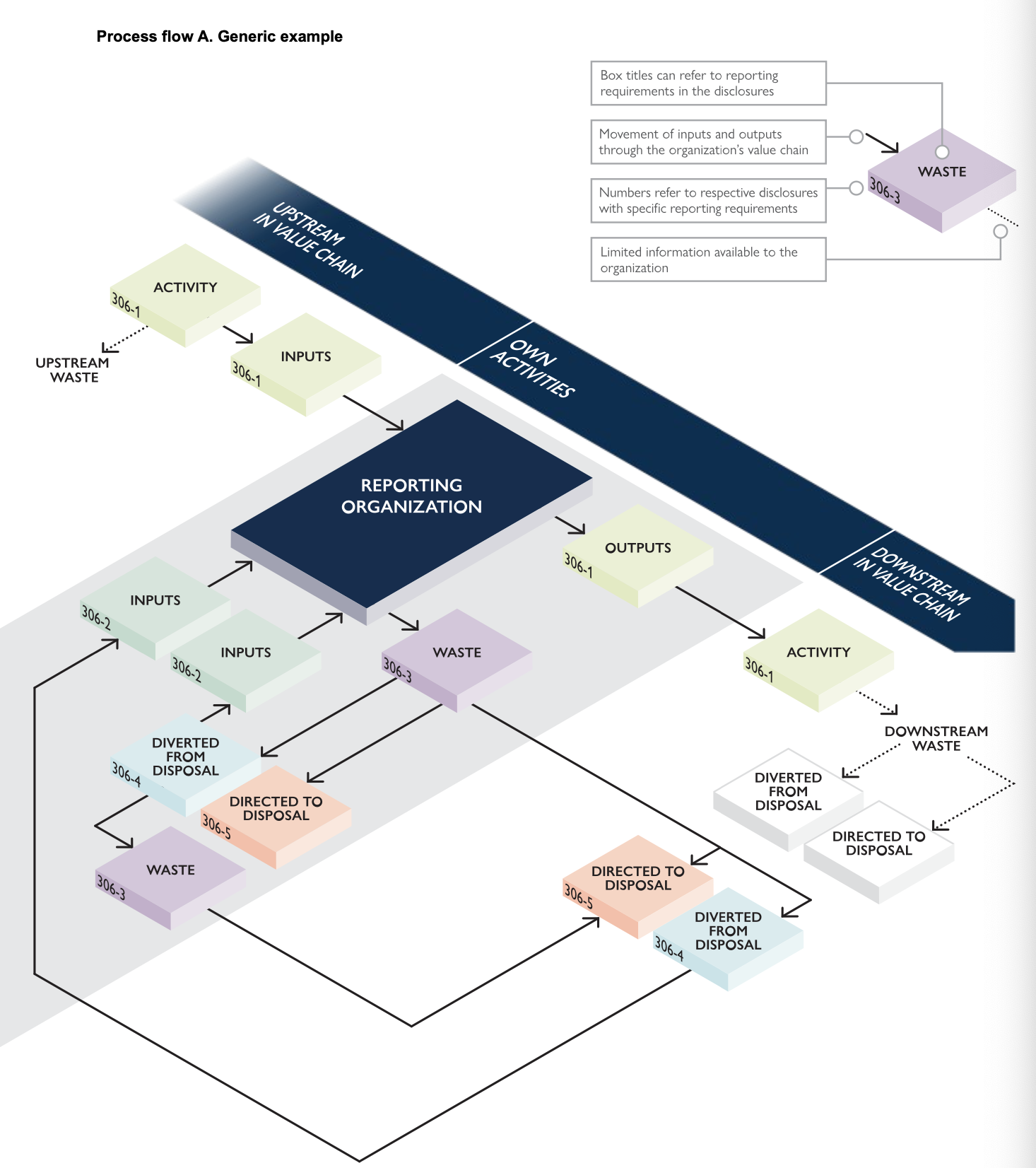
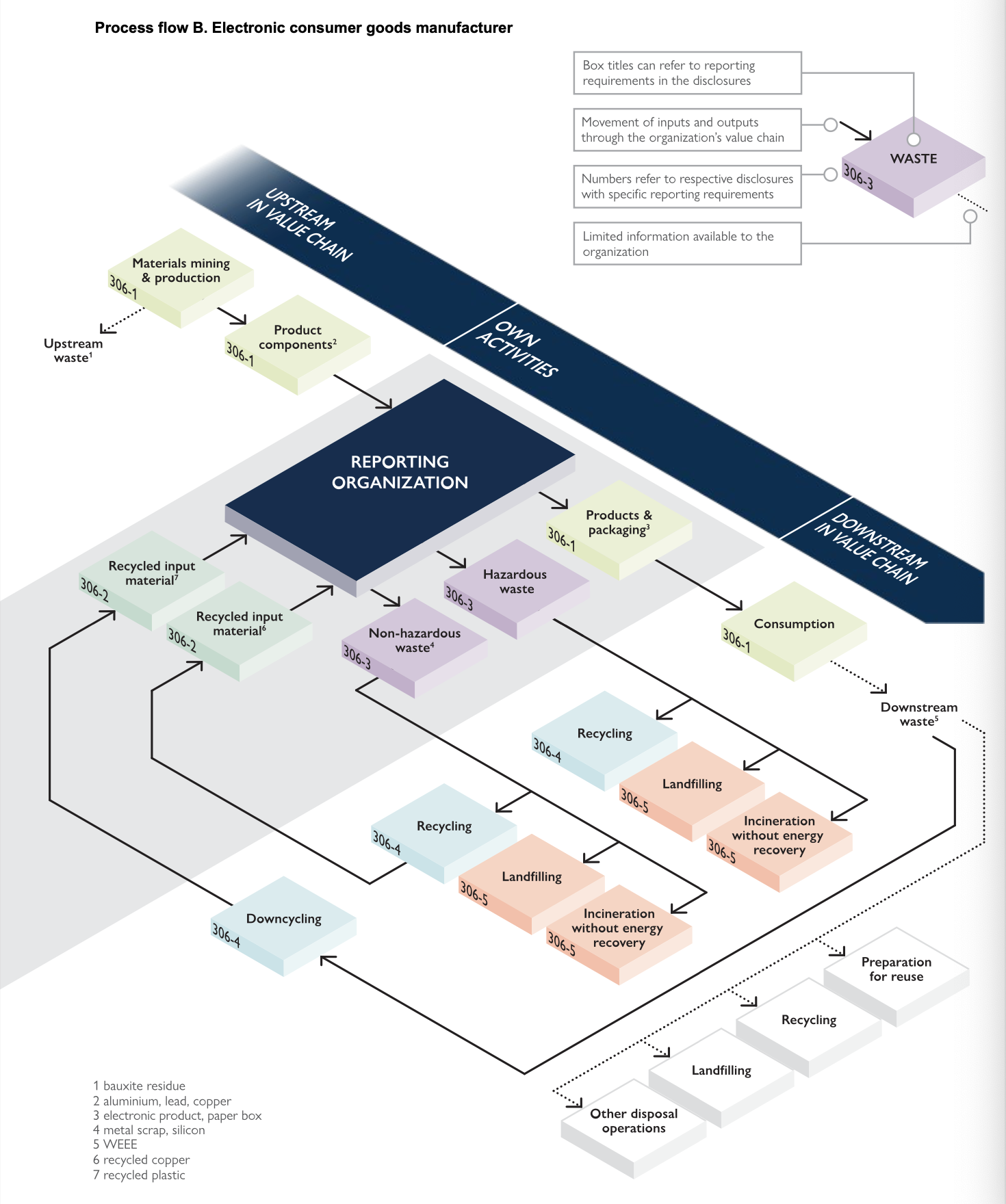

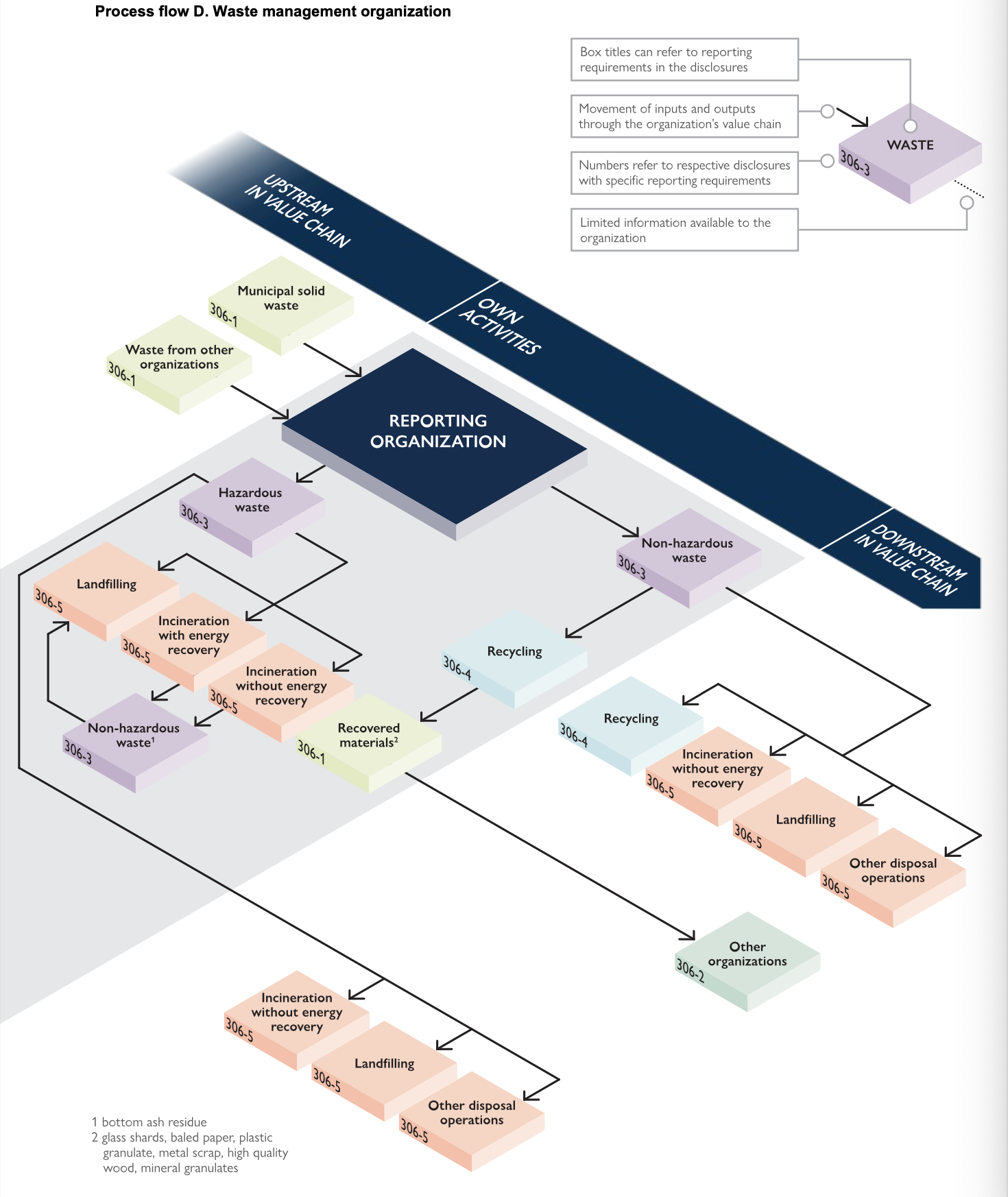
Template examples for presenting information for Disclosures 306-3, 306-4, and 306-5
Tables 1, 2, and 3 offer templates for presenting the information required under Disclosure 306-3 Waste generated, Disclosure 306-4 Waste diverted from disposal, and Disclosure 306-5 Waste directed to disposal. The organization can amend the tables according to its practices.

